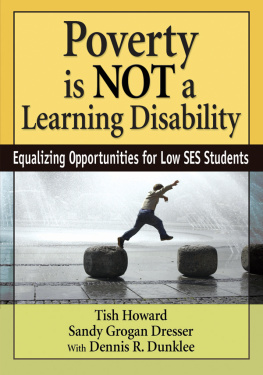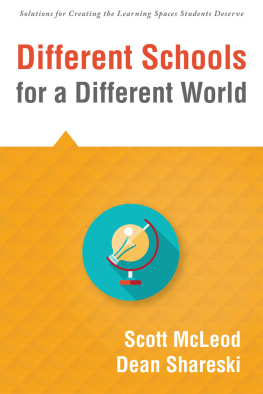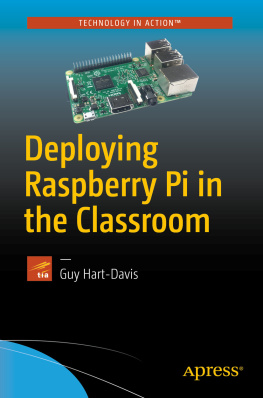Praise for Disrupting Class
Clayton Christensen and colleagues describe how disruptive technologies will personalize and, as a result, revolutionize learning. Every education leader should read this book, set aside their next staff meeting to discuss it, and figure out how they can be part of the improvement wave to come.
Tom Vander Ark, President, X PRIZE Foundation
In Disrupting Class, Clay Christensen brings to K12 education the powerful concept of disruptive innovation that has radically reshaped thinking about private sector innovation and business change. He considers the glancing impact that technology has had on classrooms, explains why this is so, and what it will take to reengineer our nations schools for the 21st century.
Frederick M. Hess, Director of Education Policy Studies at the American Enterprise Institute and author of Common Sense School Reform
American school districts are pressed by policymakers demanding achievement, by students wanting relevant learning, by teachers looking for a professionally rewarding career, and by taxpayers hoping for some improvement in productivity. If they are to respond successfully to these challenges, the path Clayton Christensen maps out will be the way.
Ted Kolderie, Senior Associate, Center for Policy Studies
Christensen, Horn, and Johnson argue that the next round of innovation in school reform will involve learning software. While schools have resisted integrating technology for instruction, todays students are embracing technology in their everyday lives. The question is whether the next innovation, truly individualized instruction, will occur inside or outside public education. This book offers promise to education reformers.
Kathleen McCartney, Dean, Harvard Graduate School of Education
Clayton Christensens advice has helped scores of major businesses. Here he applies to public education his theory about how organizations should respond to disruptive innovation... [and] shows boards and superintendents why they, too, need to run two businesses in tandem, and explains how they can do that.
Ron Wolk, Founder and former editor of Education Week
Disrupting Class gets directly to the point of how $60 billion was spent over the last two decades putting computers and learning software in schools with no effect on student achievement... concisely explains how to create learning organizations needed for future generations.
William G. Andrekopoulos, Superintendent, Milwaukee Public Schools
As a former education policymaker and a continued advisor to education companies, I have felt frustrated by the seeming intractable challenges in transforming our public schools. This book tackles that frustration and proposes a road map and sound advice for how educators and policymakers can leverage innovation to achieve excellence in our schools.
Jane Swift, Acting Governor of Massachusetts from 20012003
A decade ago, Clayton Christensen wrote a masterpiece, The Innovators Dilemma, that transformed the way business looks at innovation. Now, he and two collaborators, Michael B. Horn and Curtis W. Johnson, have come up with another, focusing his ground-breaking theories of disruptive innovation on education.
David Gergen, U.S. Presidential Advisor
Clayton Christensens insights just might shake many of us in education out of our complacency and into a long needed disruptive discourse about really fixing our schools. This will be a welcome change after decades in which powerful calls to action have resulted in only marginal improvements for our nations school children.
Vicki Phillips, Director of Education, Gates Foundation
Full of strategies that are both bold and doable, this brilliant and seminal book shows how we can utilize technology to customize learning. I recommend it most enthusiastically.
Adam Urbanski, President, Rochester (NY) Teachers Association, and vice president, American Federation of Teachers
Finally we have a book from the business community that gets it. A must read for anyone thinking and worrying about where education should be headed.
Paul Houston, Executive Director, American Association of School Administrators
After a barrage of business books that purport to fix American education, at last a book that speaks thoughtfully and imaginatively about what genuinely individualized education can be like and how to bring it about.
Howard Gardner, Author of Five Minds for the Future
DISRUPTING CLASS
How Disruptive Innovation Will
Change the Way the World Learns
CLAYTON M. CHRISTENSEN
MICHAEL B. HORN CURTIS W. JOHNSON


Copyright 2011, 2008 by Clayton M. Christensen. All rights reserved. Except as permitted under the United States Copyright Act of 1976, no part of this publication may be reproduced or distributed in any form or by any means, or stored in a database or retrieval system, without the prior written permission of the publisher.
ISBN: 978-0-07-175910-6
MHID: 0-07-175910-7
The material in this eBook also appears in the print version of this title: ISBN: 978-0-07-174910-7, MHID: 0-07-174910-1.
All trademarks are trademarks of their respective owners. Rather than put a trademark symbol after every occurrence of a trademarked name, we use names in an editorial fashion only, and to the benefit of the trademark owner, with no intention of infringement of the trademark. Where such designations appear in this book, they have been printed with initial caps.
McGraw-Hill eBooks are available at special quantity discounts to use as premiums and sales promotions, or for use in corporate training programs. To contact a representative please e-mail us at bulksales@mcgraw-hill.com.
TERMS OF USE
This is a copyrighted work and The McGraw-Hill Companies, Inc. (McGraw-Hill) and its licensors reserve all rights in and to the work. Use of this work is subject to these terms. Except as permitted under the Copyright Act of 1976 and the right to store and retrieve one copy of the work, you may not decompile, disassemble, reverse engineer, reproduce, modify, create derivative works based upon, transmit, distribute, disseminate, sell, publish or sublicense the work or any part of it without McGraw-Hills prior consent. You may use the work for your own noncommercial and personal use; any other use of the work is strictly prohibited. Your right to use the work may be terminated if you fail to comply with these terms.
THE WORK IS PROVIDED AS IS. McGRAW-HILL AND ITS LICENSORS MAKE NO GUARANTEES OR WARRANTIES AS TO THE ACCURACY, ADEQUACY OR COMPLETENESS OF OR RESULTS TO BE OBTAINED FROM USING THE WORK, INCLUDING ANY INFORMATION THAT CAN BE ACCESSED THROUGH THE WORK VIA HYPERLINK OR OTHERWISE, AND EXPRESSLY DISCLAIM ANY WARRANTY, EXPRESS OR IMPLIED, INCLUDING BUT NOT LIMITED TO IMPLIED WARRANTIES OF MERCHANTABILITY OR FITNESS FOR A PARTICULAR PURPOSE. McGraw-Hill and its licensors do not warrant or guarantee that the functions contained in the work will meet your requirements or that its operation will be uninterrupted or error free. Neither McGraw-Hill nor its licensors shall be liable to you or anyone else for any inaccuracy, error or omission, regardless of cause, in the work or for any damages resulting there from. McGraw-Hill has no responsibility for the content of any information accessed through the work. Under no circumstances shall McGraw-Hill and/or its licensors be liable for any indirect, incidental, special, punitive, consequential or similar damages that result from the use of or inability to use the work, even if any of them has been advised of the possibility of such damages. This limitation of liability shall apply to any claim or cause whatsoever whether such claim or cause arises in contract, tort or otherwise.
Next page









